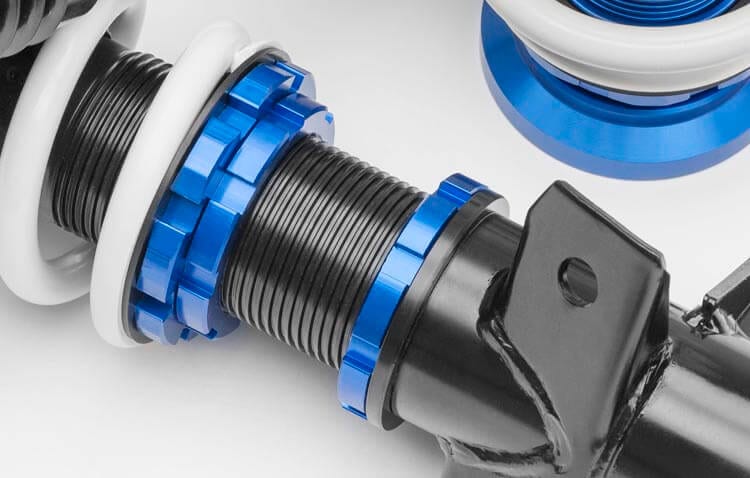So, you’ve had your coilovers installed for some time now and you’ve decided that you need to be lower or you’re tired of being the neighborhood’s snow plow and you need to raise your ride height for the winter only to find that your collars are stuck, seized, seemingly welded by mother nature. In this post, we’ll go over what you can do to break those locked collars free and what to do to prevent them from becoming seized in the future.

Top Tips
Remove the coilover from the car and clean the threading of the coilover with a wire brush, removing any debris, salt etc. that has lodged itself onto the threading of the ride height adjustment.
Next, take the removed coilover and spray the affected threading with penetration oil. We’re big fans of PB Blaster but there are other options out there that do a great job as well. Now, the key with penetration oil is time. You have to let the penetration oil work its way in between the threading of the aluminum collars and the adjustment threads on the damper body. Many of the oils on the market will not evaporate so you won’t need to keep on applying. Be sure to coat the adjusters thoroughly and let the oil go to work.

The most effective way of treating seized coilovers is by bathing the entire coilover in penetration oil, which is more expensive. However, in our opinion, we’d rather pay for a gallon of penetration oil and bathe it than damage the adjusting collars by using an air chisel/hammer, channel locks or other aggressive means. We also aren’t fans of busted knuckles so let the oil do the work and keep calm.
The other reason we recommend removing the coilover is that once you have broken the collars free, you then can remove all of the collars, treat the threads with anti seize, then reinstall the collars to prevent them from seizing again. For more information on how to maintain your coilovers, visit How To Take Care Of Your Coilovers.
If all else fails and you’re not able to break the collars free, we can send you new collars if you are able to cut the collars off. Be very careful not to damage the threads of the damper when doing so.
Most importantly, DO NOT HEAT THE COILOVER!!!!! The dampers are gas charged and by heating them it can damage the coilover or potentially cause harm to yourself.
Also, do not use any acid based liquids on the damper such as battery acid, Cola or vinegar. The acid may help in getting the rust and gunk out of the threads in order to break them free but it also will eat away at the paint and rubber components and may cause irreversible damage to your suspension.
If you have any questions, feel free to contact us.






good day to you guys, i’m from Canada and was wondering how’s the proceedure if i needed parts for my coilovers?
Give us a call with the part number on one of your coilovers and we’ll get you taken care of. Our number to call is 801.365.1440.
Just this last weekend I decided to get a pair of front coilovers off of a parts car and onto a daily of mine. The spring mounts were rather stuck. I carefully cleaned all the threads with a wire brush and some brake cleaner, and then soaked the collars in a mixture of 50% acetone and 50% automatic transmission fluid. I let them soak for a day. The next day, I put the coilovers in a vice, and whacked the coilover wrench with a dead blow hammer.
Worked like a charm. The acetone/atf mix is the best rust penetrating fluid I’ve ever used.
Recently bought a 1993 Mazda Miata with coilovers installed. Took it to a nearby garage to have it raised and they said that all 4 were fused and couldn’t be moved. Since you guys know more than I do about this stuff, any ideas? Should I cut the collars off or replace the coilovers with new suspension parts (I live in the northeast and don’t necessarily NEED coilovers)? Thanks.
The best advice that we can offer is to soak them in PB blaster and let it sit. We wouldn’t recommend heating the shocks as it can damage the oil in the dampers. If you can cut off the collars, you likely can get replacement collars for them.